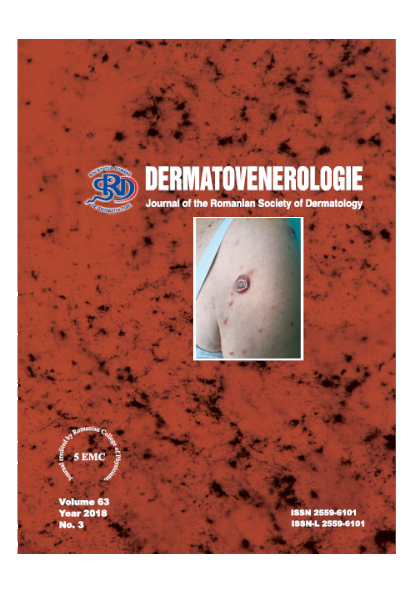Rezumat
Sifilisul este o boală infecțioasă cu transmitere sexuală
în majoritatea cazurilor, determinată de Treponema
Pallidum.
Caz clinic
Prezentăm cazul unei paciente în vârstă de 58 ani, din
mediul rural, care se spitalizează pentru o erupție papulonodulară,
dispusă difuz la nivelul corpului, cu elemente cu
dimensiuni cuprinse între 0,5-3 cm, unele de culoare roșieviolacee,
colorația dispărând ușor la vitropresiune,
acoperite de scuamă fină, în timp ce alte leziuni prezintă
necroză și ulcerații pe suprafață. Leziunile au apărut cu 3
luni înainte de momentul spitalizării, inițial la nivelul
membrelor inferioare, ulterior cuprinzând celelalte regiuni
topografice.
Cu o lună înainte de prezentarea în clinica noastră,
pacienta a fost spitalizată în Italia, unde i s-a prelevat o
biopsie cutanată, diagnosticul sugerat fiind de Limfom
cutanat plasmocitar.
Am practicat două biopsii cutanate (leziuni cu aspecte
clinice diferite), pentru a evidenția coexistența celor două
boli (sifilis/limfom). Examenul HP și imunofenotiparea,
împreună cu explorările serologice au exclus diagnosticul
de Limfom cutanat plasmocitar, precizând diagnosticul de
Sifilis secundar cu leziuni nodulare.
Discuții
Deși leziunile nodulare sunt întâlnite de obicei în
sifilisul terțiar, foarte rar sunt prezente și în sifilisul
secundar. în această situație, diagnosticul diferențial se face
cu limfoame și pseudolimfoame, cu micozele profunde,
tuberculoza, metastazele cutanate sau cu leucemidele. în
anumite situații, sifilisul secundar poate mima o afecțiune
granulomatoasă, precum lepra lepromatoasă sau
sarcoidoza. Prezența leziunilor nodulare granulomatoase în
sifilisul secundar pare să fie cauzată de o reacție de
hipersensibilitate a organismului la treponeme sau să fie o
urmare a evoluției îndelungate a infecției, ce se îndreaptă
spre stadiul terțiar.
Concluzii
Deși extrem de rar, sifilisul secundar cu leziuni
nodulare pune multiple probleme de diagnostic diferențial.
Confundarea lui cu un limfom cutanat plasmocitar poate
avea urmări dramatice pentru pacient, în cazul urmării
unui tratament antineoplazic.


